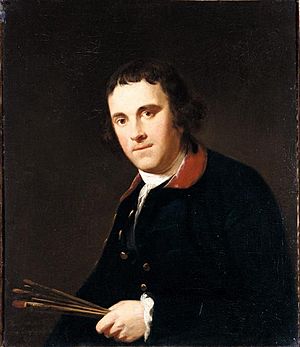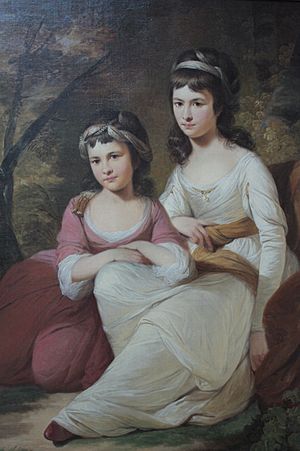Tilly Kettle facts for kids
Tilly Kettle (1735–1786) was an English portrait painter. He was the first well-known English portrait artist to work in India.
Contents
Life of a Traveling Artist
Tilly Kettle was born in London in 1735. His father was a coach painter. Tilly studied drawing with William Shipley and began painting portraits in the 1750s.
Early Career in England
Kettle's first known painting is a self-portrait from 1760. He showed his art at the Free Society of Artists in 1761. In 1762, he helped restore ceiling paintings at the Sheldonian Theatre, Oxford. He also painted Francis Yarborough, a doctor from Brasenose College, Oxford. Many members of the family of William Legge, 2nd Earl of Dartmouth also had their portraits painted by Kettle. He continued to exhibit his work in London until 1765.
Journey to India
In 1768, Kettle sailed to India with the British East India Company. He first arrived in Madras (now Chennai) and stayed there for two years. While in Madras, he painted important people like Lord Pigot and Muhammad Ali Khan. He also painted scenes that were not portraits, such as Dancing Girls (Blacks) in 1772. Another painting from this time was The ceremony of a gentoo woman taking leave of her relations and distributing her jewels prior to ascending the funeral pyre of her deceased husband in 1776. In 1768, Kettle also painted a group portrait of Sir Samuel Cornish, 1st Baronet, Richard Kempenfelt and Thomas Parry. This painting is now on display at Queen's House in Greenwich.
Life in Calcutta
Kettle moved to Calcutta (now Kolkata) in 1771. There, he painted Shuja ud-Daula and a painting called Dancing-Girl Holding the Stem of a Hookah. In 1775, he painted George Bogle, who was an important messenger to Tibet. Bogle was shown in Tibetan clothing, giving a special white scarf to Lobsang Palden Yeshe, the 6th Panchen Lama. While in India, Tilly Kettle had two daughters, Ann and Elizabeth.
Return to England and Later Life
Tilly Kettle left India in 1776 and returned to London. Soon after, in 1777, he married Mary "Polly" Paine. Mary was the daughter of a famous architect, James Paine. She brought a good amount of money to the marriage. Tilly and Mary had two children, a daughter named Mary and a son named James.
After returning to England, Kettle found he had fewer clients than before. He also faced financial difficulties. To escape his money problems, he spent some time in Ireland.
In 1786, Tilly Kettle decided to return to India. He tried to travel overland through Asia. He painted his last known portrait, The Turkish Janissary of the English Factory, Aleppo, in Aleppo. He died sometime later, possibly in the desert, before the end of 1786. The exact place and date of his death are not known.



